

Painting Instructions from Robert E. Wood
BY: BG EDITOR

Studio Guide Paint Swatches
Robert E. Wood Painting Instructions
Jun 03, 2017 — GREENWOOD, BC (BG)
Following last week's reprised article on the history of the Kettle River Art Club, today we would like to share another piece of the club's history: a small book of painting instructions from founding member, Robert E. Wood. For the last many years, this studio book has been in the possession of Marjie MacLean, given to her by an early member of the Art Club. The book is prefaced with a word of inspiration from the teacher:
Message from Robert E. Wood:
Art is a way of Life
Trust it as such and you will succeed
Painting is the approach to Art
Work at it and your rewards will be many
Like life, art only rewards those who try.
~ Robert E. Wood
Art is a way of Life
Trust it as such and you will succeed
Painting is the approach to Art
Work at it and your rewards will be many
Like life, art only rewards those who try.
~ Robert E. Wood
The book of instructions, in a small ring binder, contains several pages of color blending charts with sample paint swatches:
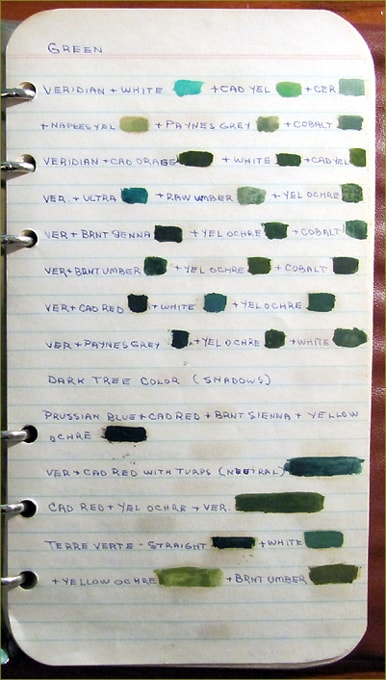
Color Blending Charts (see more, end of page)
Robert E. Wood Painting Instructions
These pages of Green and Yellow samples are followed by a number of blank pages, titled with individual colors, obviously meant for blending examples that were never completed, for blue, purple, red, brown and grey.
These are followed by another four pages containing paint swatches for color combinations. Included among the examples with painted color swatches are: base browns, color combos for skies, clouds, rocks and trees. Again, these are followed by several pages of color combination titles for which the swatches were not yet painted in.
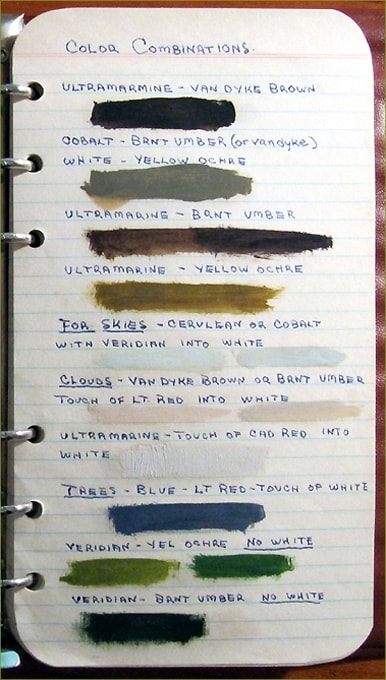
Color Combinations (see more, end of page)
Robert E. Wood Painting Instructions
Perhaps most interesting among the color combination notes is a record of the colors used on a canvas that is among the Art Club's collection of Robert E. Wood paintings. The piece is not titled, and we thought perhaps it was a First Nations boy. In fact, the piece can now be identified, thanks to the notes in this small book of art instructions, as the portrait of a Samoan boy. The colors for the painting were recorded in the studio book:
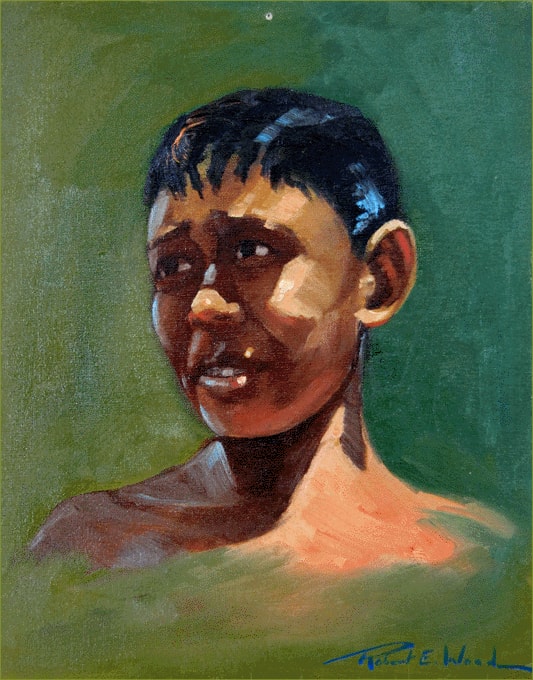
Portrait of a Samoan Boy
By Robert E. Wood
Portrait of Samoan Boy:
Dark Tone:
Burnt Umber & Light Red
Light Red & Touch Burnt Umber
Light Red & White
Cadmium Red & Orange
Hi-lite:
Cadmium Red, Yellow Ochre & White
Cobalt or Cerulean & White
Burnt Umber & Light Red
Light Red & Touch Burnt Umber
Light Red & White
Cadmium Red & Orange
Hi-lite:
Cadmium Red, Yellow Ochre & White
Cobalt or Cerulean & White
Like several of the paintings in the Art Club's Robert E. Wood collection, this piece was no doubt painted for instructional purposes, and the notes above were likely taken down as part of the demonstration.
The list of color combinations for which color swatches had not yet been painted into the book are interesting nonetheless, and give us an opportunity to experiment with the colors Robert E. Wood obviously taught were fundamental to the practicing artist's palette. Although abbreviated in the book, they are spelled out here for easy reference:
Touch of Cadmium Yellow, Naples Yellow & White
Cadmium Yellow, Orange & White
Burnt Umber, Burnt Sienna, touch of Alizarine, Cerulean & White
Cerulean, Alizarine, touch of Burnt Umber & White
Ultramarine, Alizarine & touch of Burnt Sienna
Ivory Black, touch of Ultramarine, lots of Alizarine, & touch of Cadmium Red
Light Red, Viridian, White & Burnt Sienna
Ultramarine & Yellow
Burnt Umber, Cadmium Red & Orange
Cobalt, Ultramarine & White
Light Red, Ultramarine & White
Ultramarine, Burnt Umber & Yellow Ochre
White & Orange or Paynes Grey
Paynes Grey & Light Red
Light Red, Viridian & Yellow Ochre
White, Cadmium Yellow (2 parts into 1 part)
Cadmium Orange — more white for hi-lites
Light Red, Yellow Ochre & touch of White
Paynes Grey, Cerulean & White
Ultramarine, Alizarine & Crimson
Viridian & Alizarine (or Cadmium Red)
Cobalt, Ultramarine & Burnt Umber or touch of Van Dyke Brown
Burnt Umber, White & Cerulean or Cobalt
Burnt Sienna & White
Burnt Umber & White
Burnt Sienna, Cadmium Red & Prussian Blue
Dark Tones for Trees: Prussian Blue, Cadmium Red, Burnt Sienna & Yellow Ochre
Cadmium Yellow, Orange & White
Burnt Umber, Burnt Sienna, touch of Alizarine, Cerulean & White
Cerulean, Alizarine, touch of Burnt Umber & White
Ultramarine, Alizarine & touch of Burnt Sienna
Ivory Black, touch of Ultramarine, lots of Alizarine, & touch of Cadmium Red
Light Red, Viridian, White & Burnt Sienna
Ultramarine & Yellow
Burnt Umber, Cadmium Red & Orange
Cobalt, Ultramarine & White
Light Red, Ultramarine & White
Ultramarine, Burnt Umber & Yellow Ochre
White & Orange or Paynes Grey
Paynes Grey & Light Red
Light Red, Viridian & Yellow Ochre
White, Cadmium Yellow (2 parts into 1 part)
Cadmium Orange — more white for hi-lites
Light Red, Yellow Ochre & touch of White
Paynes Grey, Cerulean & White
Ultramarine, Alizarine & Crimson
Viridian & Alizarine (or Cadmium Red)
Cobalt, Ultramarine & Burnt Umber or touch of Van Dyke Brown
Burnt Umber, White & Cerulean or Cobalt
Burnt Sienna & White
Burnt Umber & White
Burnt Sienna, Cadmium Red & Prussian Blue
Dark Tones for Trees: Prussian Blue, Cadmium Red, Burnt Sienna & Yellow Ochre
Next in the studio book are a collection of specific techniques:
Washes for Toning Canvas:
Burnt Sienna & Cadmium Orange (for warm picture)
Ultramarine & Van Dyke Brown
For outdoors (always tone canvas)
Raw Umber
Ultramarine & Van Dyke Brown
For outdoors (always tone canvas)
Raw Umber
For Blocking In and Slash Lines:
Ultramarine, Alizarine & Turps
Paynes Grey, no White & Turps
Cadmium Red, Burnt Sienna & touch Blue
Wash canvas first with turps and then work in your color
Cobalt, touch Black & Turps
Paynes Grey, no White & Turps
Cadmium Red, Burnt Sienna & touch Blue
Wash canvas first with turps and then work in your color
Cobalt, touch Black & Turps
Portraits:
3 Key Palettes:
1) Green Key Palette (7 colors = Black & White):
White
Black (Ivory)
Yellow Ochre
Cadmium Red Light or Light Red
Cadmium Red Dp
Alizarine, Crimson or Rose Madder
Veridian Green
Ultramarine Blue
This is for dark complexioned people
2) 3 Colors plus Black & White:
White
Black (Ivory)
Yellow Ochre
Light Red
Viridian Green
Used for white race deeply tanned. Also good for masculine portraits
3) Blue Key Palette (6 colors = Black & White):
White
Black (Ivory)
Cadmium Yellow Light (best)
Cadmium Red Light
Cadmium Red Dp
Alizarine, Crimson or Rose Madder
Ultramarine Blue
Cerulean Blue
Good for children, blondes & elderly people
Anyone can be painted with these colors. Proportions painted in masses first very
lightly, then:
1) Background
2) Work in light flesh tones
3) Hair (color best you can getting direction of hair)
4) Clothing (work in direction)
5) Black in dark shadows of flesh
White
Black (Ivory)
Yellow Ochre
Cadmium Red Light or Light Red
Cadmium Red Dp
Alizarine, Crimson or Rose Madder
Veridian Green
Ultramarine Blue
This is for dark complexioned people
2) 3 Colors plus Black & White:
White
Black (Ivory)
Yellow Ochre
Light Red
Viridian Green
Used for white race deeply tanned. Also good for masculine portraits
3) Blue Key Palette (6 colors = Black & White):
White
Black (Ivory)
Cadmium Yellow Light (best)
Cadmium Red Light
Cadmium Red Dp
Alizarine, Crimson or Rose Madder
Ultramarine Blue
Cerulean Blue
Good for children, blondes & elderly people
Anyone can be painted with these colors. Proportions painted in masses first very lightly, then:
1) Background
2) Work in light flesh tones
3) Hair (color best you can getting direction of hair)
4) Clothing (work in direction)
5) Black in dark shadows of flesh
Line and form are essential
Sketch first before attempting to paint portraits. Use a 3B or 2B pencil. Sharpen long & tapered. Work in Black & White. Study bone structure.
Finally, the studio book contains a section of instructional wisdom on technique and painting practice.
Good Advice from Robert E. Wood:
Don't paint pictures, paint subjects
Be Individual
Master one thing at a time — practise trees, rocks, clouds etc. by themselves until you feel you know how to do them.
Don't sit at your picture constantly, walk away from it. You'll get a better perspective.
Everything has movement. Gravity of a bowl on a table is movement.
Action is the clouds moving in the sky — the wind blowing the trees
A spoon in a bowl provides movement and action
Movement — action — texture (with least possible strokes)
Tone comes before color
Red is a color — Cadmium Red is a hue
Tones — light, medium, dark
Don't use too much White
Adding White is tinting
Adding Black is shading
Never use Black alone — or Yellows
Mix most colors
Do not use White alone
Mix colors from light to dark
Horizons:
High horizon — high view
Low horizon — low view
Below centre of canvas — looking down
Above centre of canvas — looking up
Reflections:
Light is the secret of painting
Light & Shadows:
Increase light — increase depth of shadows
Decrease light — decrease depth of shadows
Be Individual
Master one thing at a time — practise trees, rocks, clouds etc. by themselves until you feel you know how to do them.
Don't sit at your picture constantly, walk away from it. You'll get a better perspective.
Everything has movement. Gravity of a bowl on a table is movement.
Action is the clouds moving in the sky — the wind blowing the trees
A spoon in a bowl provides movement and action
Movement — action — texture (with least possible strokes)
Tone comes before color
Red is a color — Cadmium Red is a hue
Tones — light, medium, dark
Don't use too much White
Adding White is tinting
Adding Black is shading
Never use Black alone — or Yellows
Mix most colors
Do not use White alone
Mix colors from light to dark
Horizons:
High horizon — high view
Low horizon — low view
Below centre of canvas — looking down
Above centre of canvas — looking up
Reflections:
Light is the secret of painting
Light & Shadows:
Increase light — increase depth of shadows
Decrease light — decrease depth of shadows

Reflection Angles and Positioning
Robert E. Wood Painting Instructions
Water:
Rough water — less reflection
No color to water — it's sunlight and atmospheric conditions
Water is clearer in winter, more cloudy in summer due to sun's position & algae in water
For Hardboard — hyplar gesso to smear on smooth side
Exacto Knife — for carving soapstone
Good book on Painting: Pull Up an Easel & Paint (at Bay or Eatons)
Brush Strokes:
Cross stroke for sky
Fan shape for clouds
Primary Colors:
Yellow, Blue, Red
Secondary Colors:
Orange, Violet, Green
Rough water — less reflection
No color to water — it's sunlight and atmospheric conditions
Water is clearer in winter, more cloudy in summer due to sun's position & algae in water
For Hardboard — hyplar gesso to smear on smooth side
Exacto Knife — for carving soapstone
Good book on Painting: Pull Up an Easel & Paint (at Bay or Eatons)
Brush Strokes:
Cross stroke for sky
Fan shape for clouds
Primary Colors:
Yellow, Blue, Red
Secondary Colors:
Orange, Violet, Green
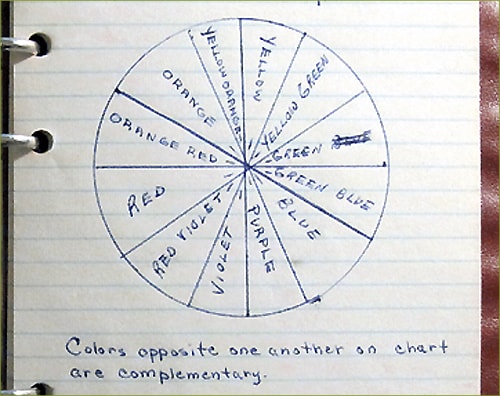
Color Wheel
Robert E. Wood Painting Instructions
Colors opposite one another on chart are complimentary.
If your basic color is Green you must use Red in your picture to complement it.
Color Key:
1-4-9 — Use either way on chart
e.g., 1-Blue — 4-Red Violet — 9-Yellow
or 1-Blue — 4-Yellow Green — 9-Red
If your basic color is Green you must use Red in your picture to complement it.
Color Key:
1-4-9 — Use either way on chart
e.g., 1-Blue — 4-Red Violet — 9-Yellow
or 1-Blue — 4-Yellow Green — 9-Red
The studio book of Robert E. Wood's painting instructions ends on a serious note, with a warning of two highly toxic pigments:
Cadmium Green — Emerald Green — Poison
A collection of 17 paintings by Robert E. Wood, including the Portrait of a Samoan Boy, will be exhibited at this year's Founders Day event, July 8th & 9th, as part of the celebration of Greenwood's 120th Anniversary.
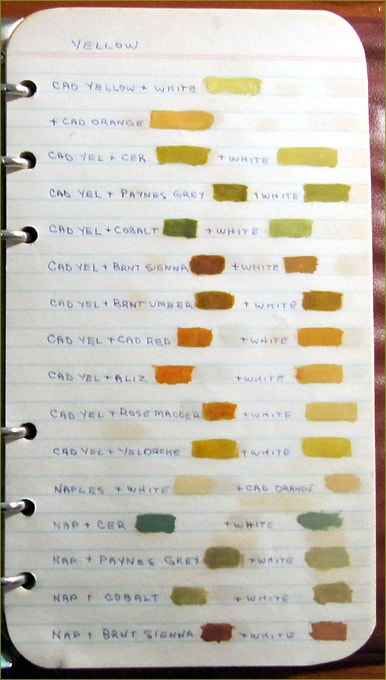
Color Blending Charts
Robert E. Wood Painting Instructions

Color Blending Charts
Robert E. Wood Painting Instructions
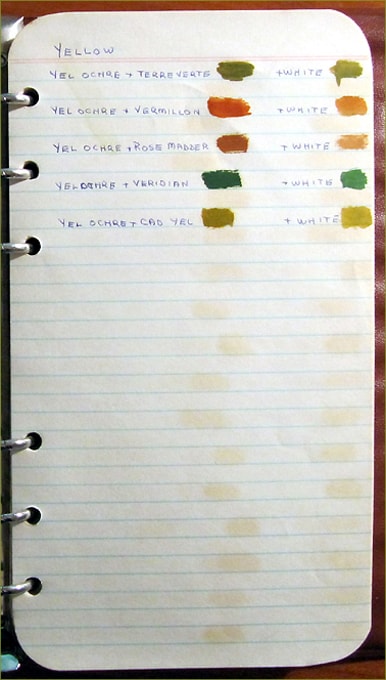
Color Blending Charts
Robert E. Wood Painting Instructions
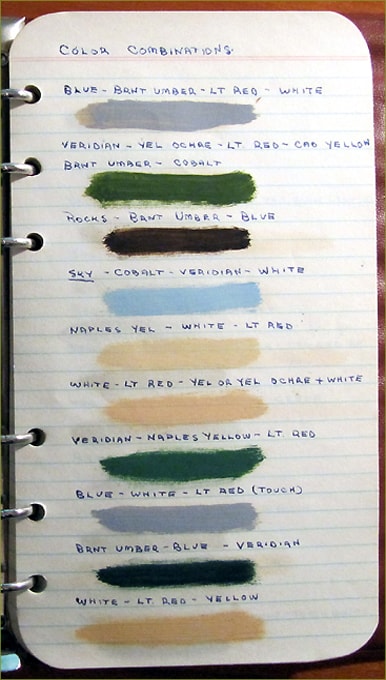
Color Combinations
Robert E. Wood Painting Instructions

Color Combinations
Robert E. Wood Painting Instructions
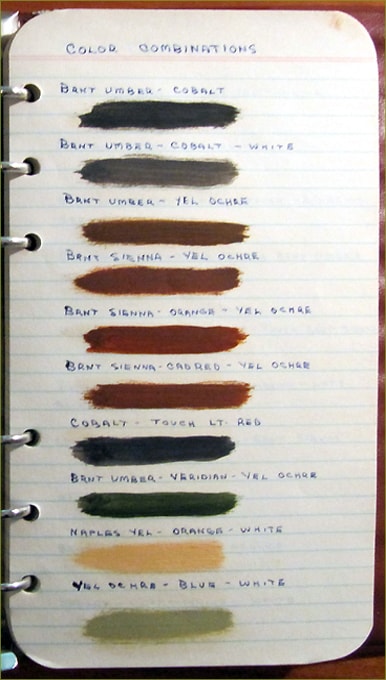
Color Combinations
Robert E. Wood Painting Instructions


